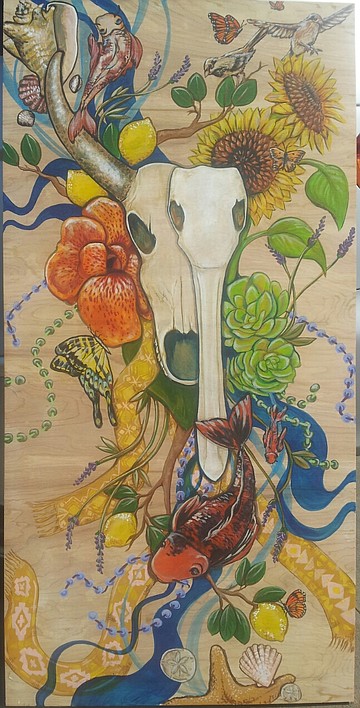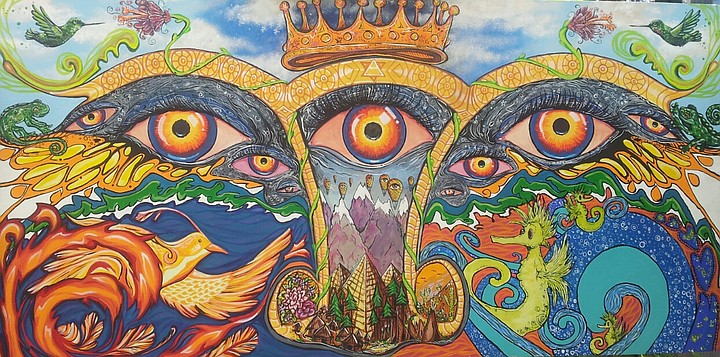 Facebook
Facebook
 X
X
 Instagram
Instagram
 TikTok
TikTok
 Youtube
Youtube


Paintings from Hill Young’s new series depict animal skulls surrounded by organic life. Flowers and vines spring from the wood of the panel, enclosing the bleached bones in a web of living matter. As a self-confessed "nature girl," it's no surprise that the images of the natural world appeal so strongly to the painter.
Young says, “[Haydn Street]—the one with a cow and pelican skull—came out of a vacation house that I stayed in with my mother in Encinitas. I found all the elements of the painting there. There’s an amazing garden...and a koi pond...and all these tropical flowers. I spent a day up there and then I came home and painted all night. I got up the next day and went right back to painting. I spent a lot of time on it, more than I would normally have done. Sometimes, I just start painting and I don’t really know why. But this time, within a week of starting the new series, I understood what it was about.
“The idea behind these paintings is one of life growing out of death. I’ve gone through a lot of death in my world lately. Literally. But also figuratively; the death of old attitudes, and such. Ideas of death can be very positive. They can be viewed as opportunities for change and growth.”
That classic tarot card interpretation of death as a symbol for change—as opposed to an unmitigatable tragedy—is a hard pill to swallow. Many people spout the conventional wisdom, but few can really embrace it, let alone live it. For Young, life has been a series of challenges since losing her father two years ago. She explains that he was an artist, and how her decision to go all-in with her painting is a choice to honor him and create an opportunity out of the sadness.
“I’ve been painting full-time since January,” she says. “I’ve never been happier. I’m fully committed to my passions. It’s pretty simple, when you think about it. I had all this superfluous stuff that I thought I had to do to survive, but it turns out that whatever I want to do, whatever I want my reality to be, I can do that. Plus, I get to tell people that I paint all day, and that’s pretty cool. People are very shocked to hear that I’m a full-time artist, like, ‘oh, wow! You can do that?’ And just want to say, ‘yeah, and you could too!’ You can do whatever you want. It’s within your power to just go out and do it.”

Artistry, much like other things, doesn’t happen in a vacuum. Much of Hill Young’s inspiration to to stay motivated about her artwork has come through interactions with local artists, many of whom she meets through her involvement with the Infusion Project. She coordinates live painting events in San Diego for the group, which has a presence in major cities all over the US. The idea behind the project is to get artists collaborating with each other, which can be strikingly problematic, as Charles Page indicated in his recent interview with the Reader. For Young, being involved with the communal, live painting exhibitions keeps her exposed to new styles and ideas, which fuel her own desire to keep painting and stay dedicated to her artwork.
“My artwork has gotten better because of my keeping people around me who are working hard on their art,” she says, succinctly.
Surrounded by that, it’s possible, though never easy, to see challenges as opportunities for growth, rather than reasons to curl up in the corner.



Paintings from Hill Young’s new series depict animal skulls surrounded by organic life. Flowers and vines spring from the wood of the panel, enclosing the bleached bones in a web of living matter. As a self-confessed "nature girl," it's no surprise that the images of the natural world appeal so strongly to the painter.
Young says, “[Haydn Street]—the one with a cow and pelican skull—came out of a vacation house that I stayed in with my mother in Encinitas. I found all the elements of the painting there. There’s an amazing garden...and a koi pond...and all these tropical flowers. I spent a day up there and then I came home and painted all night. I got up the next day and went right back to painting. I spent a lot of time on it, more than I would normally have done. Sometimes, I just start painting and I don’t really know why. But this time, within a week of starting the new series, I understood what it was about.
“The idea behind these paintings is one of life growing out of death. I’ve gone through a lot of death in my world lately. Literally. But also figuratively; the death of old attitudes, and such. Ideas of death can be very positive. They can be viewed as opportunities for change and growth.”
That classic tarot card interpretation of death as a symbol for change—as opposed to an unmitigatable tragedy—is a hard pill to swallow. Many people spout the conventional wisdom, but few can really embrace it, let alone live it. For Young, life has been a series of challenges since losing her father two years ago. She explains that he was an artist, and how her decision to go all-in with her painting is a choice to honor him and create an opportunity out of the sadness.
“I’ve been painting full-time since January,” she says. “I’ve never been happier. I’m fully committed to my passions. It’s pretty simple, when you think about it. I had all this superfluous stuff that I thought I had to do to survive, but it turns out that whatever I want to do, whatever I want my reality to be, I can do that. Plus, I get to tell people that I paint all day, and that’s pretty cool. People are very shocked to hear that I’m a full-time artist, like, ‘oh, wow! You can do that?’ And just want to say, ‘yeah, and you could too!’ You can do whatever you want. It’s within your power to just go out and do it.”

Artistry, much like other things, doesn’t happen in a vacuum. Much of Hill Young’s inspiration to to stay motivated about her artwork has come through interactions with local artists, many of whom she meets through her involvement with the Infusion Project. She coordinates live painting events in San Diego for the group, which has a presence in major cities all over the US. The idea behind the project is to get artists collaborating with each other, which can be strikingly problematic, as Charles Page indicated in his recent interview with the Reader. For Young, being involved with the communal, live painting exhibitions keeps her exposed to new styles and ideas, which fuel her own desire to keep painting and stay dedicated to her artwork.
“My artwork has gotten better because of my keeping people around me who are working hard on their art,” she says, succinctly.
Surrounded by that, it’s possible, though never easy, to see challenges as opportunities for growth, rather than reasons to curl up in the corner.
Comments